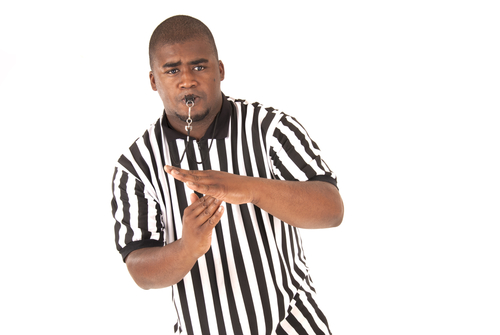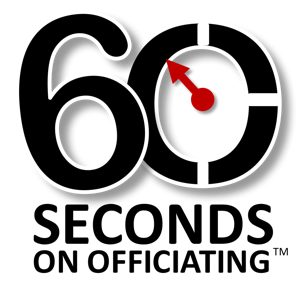
Technical Advisor: Crossing Your T’s
Some techniques to keep you out of hot water and handle NFHS technical foul situations.
The events in a high school basketball game that precede an official calling a technical foul on a player, coach or bench personnel can be a simmering pot of verbal abuse that has finally boiled over; or an ‘explosion’ of conduct that seemingly came out of nowhere, but however you arrived at this moment, you and your crew need to be certain that you don’t add to the stress level by incorrectly administering the procedures for a Technical Foul.
Let’s take a moment to review a few key points related to properly administering a “T” in a NFHS contest; and close with a few suggestions that may help you avoid having to ‘drop the hammer’:
- Each single technical foul carries the penalty of two free throws (FT’s) and the offended team taking possession of the ball at the division line.
- Shoot FT’s In Order — If A-1 is fouled in the act of shooting, and B-1 receives a technical foul for protesting the call, A-1 shoots the FT’s FIRST (with no players lined up), THEN Team A shoots the FT’s for the technical foul.
- Shoot The FT’s At The Right Basket — An obvious statement, but not always automatic when your heart is racing a bit and you’re moving from both benches and the scorer’s table explaining the call.
- Double Technical Fouls (i.e. A-1 and B-1 start jawing at each other) result in NO FT’s being awarded to either team, and play is resumed at the Point Of Interruption (POI).
ALL Technical Fouls (Except Indirect Technicals) are tallied towards the Team Foul Count as it relates to the Bonus situation.
Players and bench personnel can receive a maximum of TWO technical fouls before being disqualified from the game…Coaches are disqualified after TWO direct technical fouls, or a combination of THREE direct/indirect technical fouls.
Head coaches are tagged with an indirect technical foul when another player or bench personnel are issued a technical for one of the following scenarios:
- A player dunking or grasping the rim during warm-ups.
- An unsportsmanlike act by an assistant coach, bench personnel, or a player after they have been disqualified.
- A player removes their jersey/pants in the playing area.
- A player leaves the bench during a fight/confrontation.
And any SINGLE flagrant foul (personal or technical) results in the automatic ejection of the player, coach or bench personnel, and the offended team will shoot TWO FT’s and receive the ball at the division line.
Now the time-tested adage of only responding to direct questions, and not statements made by coaches or players, is solid advice, but a measured remark by an official delivered in a calm manner to a coach (in lesser cases to a player) who seems to be squealing about everything (“over the back!”; “three seconds!”; that’s a walk!” etc., etc…) may help to dial down the temperature of the coach by offering a short, empathetic comment:
- “Coach, I hear you; I’ll take a look at it.”
- “Coach, give us a chance to ref and manage the game.”
- Coach, that’s not what I saw.”
- “Coach, if it happened that way, then I missed it.”
If that doesn’t take some of the steam out of the coach, then you may want to consider offering a sterner comment that is accompanied with a clearly visible stop sign:
“Coach, that’s enough. No more tonight.”
And then step away and take your concentration and officiating talents up a notch, and be ready to handle your business, if the coach leaves you no other option.
It is true that, most times, coaches and players “T” themselves; the officials are just the messenger.
So if you have to call a technical foul; then call it, and be sure to administer it correctly, and you’ll likely find the game will flow much smoother from here.
NFHS Rule Reference: 10-1-4

During a time-out. Is a coach allowed to take a player back onto the court to explain to that player something their doing wrong?
If you look at rule 1-13-3 the time out area is quite large. I would say that the coach can use the space allowed to teach/coach his/her players within that space. I would not have an issue with a coach working within that defined area. If the activity was taken out of that defined area I would say that you might want to address it.
I use the phrase “coach, you made your point”. That lets him know that I heard him also gives the message of I don’t want to hear about it anymore. This gives me some choices of how I want to proceed if he continues. Ignore or Tech.
I find that phrases like “that’s enough coach, no more tonight” draws a line in the sand and requires action if they continue to argue. You have to react or lose credibility for the rest of the night.
Whatever works best for your personality is how you should handle it.
well , when I use the term – ” that’s enough coach ” , and also tell my partners that the coach has been warned – I am drawing a line in the sand . I will not let that coach continue to work the Officials rather than coach his/her team .
So then if he says another word, you have to tech him. ie. “that’s enough coach” he says “really?” May work for you, but I don’t want to be in that position. Not saying it’s wrong, just that my approach works well for me. Like I said, do what makes you comfortable and controls adverse situations to your satisfaction.
Players are “disqualified” from high school games – not “ejected,” technically speaking.
The calling official should administer the free throws while the third takes care of the players and/or the coach. I haven’t heard of any other procedures to be used.
I feel that pregame speech should cover conduct. We should not have to coach players or coaches. We should officiate.
How do you handle an intentional foul on a shooter and the basket goes in? Do they shoot techs and a free throw and where does the ball come in?
An intentional foul on a shooter who makes the basket is awarded two shots and the ball is given out at the point of interruption. Also, when an official has to administer a technical foul, there is no need to go into all kinds of antics and gesticulations. Administer it calmly, and don’t allow anyone to think they have really pushed your buttons. Just do your job professionally and move on.
If, I issue a technical foul to the coach, I report the foul to the table and go to division line opposite the table. That way, I am away from the coach and if he I still barking, my partners will issue the second technical. That is something we discuss in pregame.
It seems like all Technical fouls are proceeded by taking the ball out of bounds at the Division Line. Beside an intentional foul, which you take the ball out of bounds at POI, what other technical fouls are proceeded by taking the ball at Point of Interruption?
Double technical fouls/simultaneous technical fouls have no FT’s associated with them, yet they throw-in is administered at POI.
What is the procedure for a technical foul called on defense before a bonus free throw situation.
Team is still permitted a free throw (front end of the bonus) with no players on the line. If they make one then they get another (bonus) free throw. The technical foul is administered after the completion of the common foul free throws.
Team is still permitted a free throw (front end of the bonus) with no players on the line. If they make one then get another (bonus) free throw. The technical foul is administered after the completion of the common foul free throws.
You have a player who gets a tech for a pre-game dunk. Then the same player gets a tech later in the game for hitting the ball out of a throwers’ hand. Is this a disqualification or an ejection? Meaning, is he suspended for the next game?
Trying to find this one. Team A has the ball for a last sec shoot. As the ball goes up. Team A player trying to time the ball for a dunk and misses it hangs onto the rim partner “T’s him and we also have a buzzer. Team B shoots the technical and then start thinking who should get the ball to start eh 4th. Arrow has Team B, but should Team B get the ball from the Technical and then keep the arrow???
what is rule if player bumps into a ref, accidently?
What is the ruling on a bench coach talking to officials during a time out technical